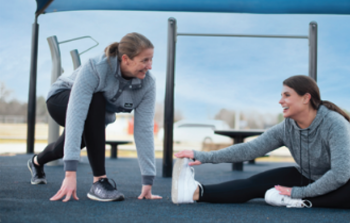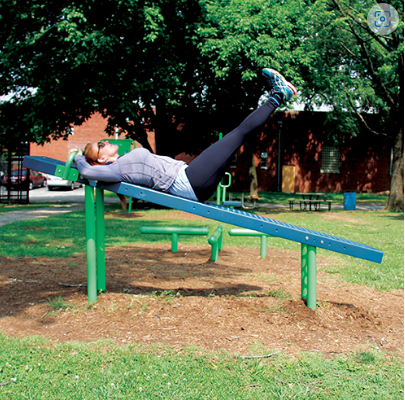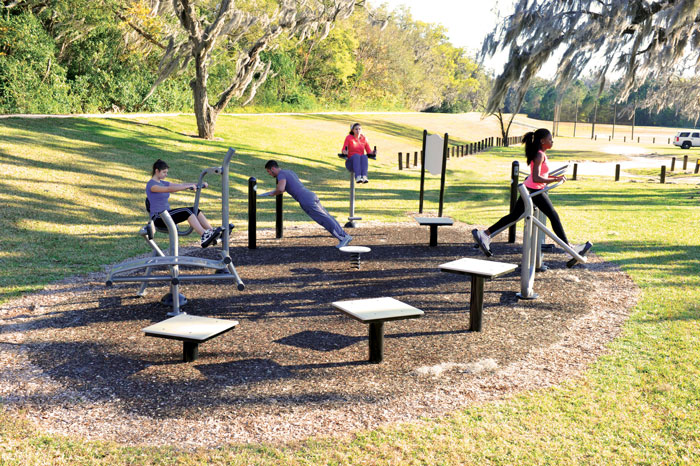Spurred by the isolation and quarantine demanded by the pandemic, more and more people chose outdoor exercise and have continued using that option long after social distancing requirements expired. Many gyms have tried to help by starting outdoor fitness classes, and manufacturers innovated with home workout products.
Running and cycling have always been out-of-the-home choices for the fitness-minded and had the one advantage indoor fitness doesn’t: They’re free. The craving for other outdoor exercise that can replicate the indoor experience with all its options for cardio, strength and balance has led to a boom in outdoor fitness equipment, usually located in parks or along trails.
Communities have taken to installing these areas to please current residents and attract new ones. The setups range from simple and inexpensive bars for strength exercises and manually operated cardio machines such as ellipticals to ninja-style obstacle courses and a broader array of equipment types for larger budgets. Some communities tout the ability for adults to use the fitness zones adjacent to playgrounds so they can keep their kids in sight. Others provide programming.
In all cases, people of a wide range of ages and abilities can use the equipment to build strength, stamina, balance and flexibility while socializing and enjoying the extra benefits only fresh air and sunshine can provide.
During the pandemic, Hillsborough County (Mich.) Parks & Rec acknowledged the necessity for additional outdoor amenities to accommodate public use, given the restrictions imposed on indoor spaces.
“By strategically selecting locations, we pinpointed five neighborhood  parks with high population density, easily accessible through walking trails and sidewalks, to install fitness zones,” said Mikah Collins, program coordinator with Hillsborough County Parks & Rec. “The primary objective of this initiative was to foster physical activity in a safe, open-air environment throughout the pandemic.
parks with high population density, easily accessible through walking trails and sidewalks, to install fitness zones,” said Mikah Collins, program coordinator with Hillsborough County Parks & Rec. “The primary objective of this initiative was to foster physical activity in a safe, open-air environment throughout the pandemic.
“The reception has been overwhelmingly positive, with a significant number of the public actively utilizing the fitness zones, accompanied by considerable interest from the media. Encouraged by this response, our efforts are focused on expanding the initiative by installing five additional fitness zones in other parks with high population densities.”
The annual fitness trends report from the American Society of Sports Medicine (ACSM) reflects the boom of outdoor fitness since the onset of the pandemic: Outdoor exercise was the No. 6 trend in 2023, No. 3 trend in 2022, No. 4 in 2021, No. 13 in 2020, and No. 17 in 2019.
The author of the annual reports, Walter Thompson, Ph.D., said the only things slowing the outdoor fitness excitement is the easing of pandemic restrictions and scorching Mother Nature. “The heat in many parts of the country has forced people indoors, as has bad weather and resulting flooding,” Thompson said. “My hope is that once the high temperatures, humidity and unconventional weather patterns are behind us that people will once again discover the great outdoors.”
Mike Etchison has weathered the surge from his role as owner of a turnkey design and development firm for outdoor recreational products and services, based in Escondido, Calif.
“Clearly, COVID caused people to rethink how to both enjoy the outdoors and work out in the outdoors,” said Etchison. “Outdoor fitness is exploding across multiple types of applications to include all age groups, and is here to stay and will be expanding moving forward within the recreation community.”
Etchison isn’t shy about what an outdoor fitness area can cost. The results may be free to the public, but certainly not to municipalities. He said in addition to design services and equipment costs, installation labor expenses exploded in 2023. “Costs are always a challenge,” he said. “If your budget is healthy, consult with a manufacturer’s representative who has done this type of work previously.”
Allison Abel, marketing chief of an outdoor fitness equipment manufacturer based in California, gives examples of smaller and larger budget options her company has helped with, and explained that whether the project is small or large, resident input and planning are crucial.
Abel said an outdoor gym expansion at a small park under an overpass in San Francisco involved adding a few functional units. “This gym is used heavily by a local calisthenics group that started going there before the pandemic and were able to continue using it during the shutdown,” she said. “This outdoor gym shows that even with a few pieces of equipment, a full range of exercises can be done and the needs of the community can be met.”
For a larger-budget project, Abel mentioned a church in central Ohio that installed one of the company’s ninja courses on its property. “This obstacle-like course is filled with challenges, so park users can train like they’re on TV,” Abel said. “Overall, the courses combine fitness and play, which is perfect for teens and young adults to get moving in the fresh air. They are essentially playgrounds for older kids who have already outgrown the traditional playground.”
The trend in outdoor exercise dovetailed with the trend of a certain style of fitness, Abel said. “Prior to COVID, we were starting to see more interest in functional fitness,” she said. “This was even more pronounced during the pandemic, so I would say it probably sped up adoption of bringing this style of outdoor fitness equipment into public spaces.
“It’s great that what formerly existed only indoors now is available outdoors, so that users get not only physical benefits but the added mental health boost of being in nature.”
Scott Roschi, creative director at a play and fitness equipment manufacturer based in Delano, Minn., expanded on the common-sense approach to adding outdoor fitness areas, regardless of budget. He said organizations should start by determining the purpose and objectives of their outdoor fitness environment.

“Are you aiming to promote overall health and well-being, encourage community engagement, or offer specific fitness classes?” said Roschi. “Clearly defining your goals will guide your decision-making process and help you choose the right outdoor fitness equipment solution.”
Roschi said after the goal-setting comes the space assessment. Consider the size, layout and surrounding facilities. Next, evaluate the needs and preferences of the people who will be using the space, including the target age groups. This information helps determine the type of outdoor fitness equipment that will best suit the environment as well as any associated programming to introduce, he said.
“Once you have created an outdoor fitness environment—whether it’s for children, adults or both—connect with experienced experts in fitness programming,” said Roschi. “They can help create fitness classes or events, such as outdoor yoga or group workouts. Their professional guidance will assist in developing a well-rounded outdoor fitness program that caters to various age groups and fitness levels.
“Best of all, these shared experiences will foster a sense of belonging, encourage social interaction and strengthen community bonds.”
For clients with smaller budgets, Roschi suggests adding individual fitness stations like pull-up or parallel bars along existing paths because they can fit compactly alongside the path and don’t require costly safety surfacing. Roschi’s company offers a fitness equipment circuit with shade structures that combines pieces designed for strength, cardio, balance and flexibility training into a compact space.
“The realization that parks and playgrounds were a necessity to make a community desirable prior to the pandemic was amplified during the pandemic,” Roschi said. “We’ve seen the investments in these spaces grow exponentially post-pandemic.”
Tory Miedema, park development specialist for the city of Sioux Falls, N.D., said the addition of outdoor fitness equipment to Rotary Park was born of community feedback and research. The city has more than 80 public parks and a 29-mile paved bike trail that wraps itself around the city along the Big Sioux River greenway.
Miedema said the city is fitness-minded, with the mayor having set a goal for Sioux Falls to be the healthiest city in America. An annual challenge to the citizens to log 100 miles in 100 days was well received, he said, and the recreational trail loop around the city has been one of the main engines to help them reach that goal.
“We also conduct a citizen survey every five years as part of our Parks & Recreation System Plan, and adult fitness and wellness ranked as a top priority for investment in our 2020 results,” said Miedema.
 “Youth fitness and wellness also ranked very highly. After researching national trends and reviewing our current offerings, outdoor fitness equipment seemed like a perfect fit to enhance our very popular recreational trail system and provide another fitness option to address the citizens’ feedback we received.”
“Youth fitness and wellness also ranked very highly. After researching national trends and reviewing our current offerings, outdoor fitness equipment seemed like a perfect fit to enhance our very popular recreational trail system and provide another fitness option to address the citizens’ feedback we received.”
Once committed to the plan, the team consulted with fitness providers and several manufacturers to get the right mix of equipment. It needed to be hardy enough for the severe winters of North Dakota, Miedema said.
The result is an offering that includes exercise bikes, an arm-pedal bike, a cross-trainer machine, box jump stations, push-up bars, pull-up bars, climbers/monkey bars, kettlebell stations, sit-up/abdominal benches, speed ladders and agility stations. Additionally, the equipment provider has developed a free phone app that provides detailed instructions on how to use the equipment, as well as the ability to generate and track individual workouts, said Miedema.
The department will be tracking attendance and participation in the programming it offers at the fitness court, as well as in any programming it partners in with other organizations, said Miedema. While it won’t have staff at the fitness court on a regular basis, it can also get a good feel for usage from the operations team that works in the park. There are also plans for staff to do informal surveys periodically to see what users like or dislike and what they would like to see in the future.
“It’s been very well received to date,” he said. “A lot of usage in general, and classes have been full so far. We will continue to monitor usage through the summer, but the feedback so far is pointing to the need for more.
“The fitness court is providing free access to the functional fitness equipment one would typically find in fitness clubs without the need to buy memberships. Access and options for programming are key to helping us reach more of our community.”
For communities mulling such a project, Miedema said he’d encourage them to work with their local fitness providers to help with equipment selection, programming and promoting, and then choose the right location and setup for the fitness zone.
“We were lucky to get great advice from partners like Great Life (golf and fitness club) to get the right type of equipment, and very fortunate to have an asset like the recreation trail loop to locate our court next to for high visibility and compatibility of use,” he said.
Anne-Marie Spencer, corporate vice president of marketing for a manufacturer of fitness, play and recreation equipment with headquarters in Chattanooga, Tenn., suggested another way smaller-budget entities can get what they want in an outdoor fitness area—spaces can be designed in stages, and then expanded or added to as budget allows. “In those instances, it’s a good idea to start with apparatus that can serve many purposes,” Spencer said. “Pull-up bars are a good example. Besides pulling up, they can be used for dead hangs, grip development, core engagement, stretching and more.”
Spencer said when choosing equipment, operators should consider the activities and how they contribute to a well-rounded workout. Outdoor fitness areas generally have fewer stations than a gym, so choosing equipment for aerobic engagement, balance and flexibility, plus core and muscle development is critical. “Balance and flexibility are important as we age, and are often overlooked in outdoor fitness planning,” she said.
On the topic of aging, Spencer said the pandemic affected the way different generations of families enjoyed time together. Parks and well-designed outdoor fitness zones can help keep that mix alive.
There has been a greater resurgence of the family staying and playing together,” she said. “Because of COVID, a lot of generation-specific activities were unavailable so families would play, walk and recreate in more intergenerational groups. That has continued in many cases, and parks seek intergenerational activities and infrastructure that can be enjoyed by people of all ages. “For example, trails can feature adult fitness and play apparatus along a trail, designed to be respectful of use zones, but still maintaining sight lines.
Collins, from Hillsborough County, stressed that although location and equipment are very important, success hinges on profiling the target user groups and providing what they need.
Don’t forget basic human care, he said. “Prior to commencing the project, it is advisable to start with small steps and identify specific areas requiring attention,” he added. “To foster resident involvement in maintaining the amenity, consider installing benches and trash receptacles near the fitness zones. Additionally, recognizing the significance of shade, if integrated shade systems are not feasible, planting large shade trees near the zones and situating benches beneath them can provide a refreshing respite between workouts.”
For Hillsborough County’s fitness zones, he said, “The final design of the project prominently incorporated key elements such as integrated shade structures, body weight resistance machines and ADA-accessible equipment. This approach aimed to enhance the overall user experience by providing comfortable and shaded areas, versatile workout options, and ensuring inclusivity for individuals with disabilities.”
Collins said it’s also important for operators to set clear goals and regularly measure against them. The primary objective for Hillsborough County Parks and Rec was to grant residents access to health and wellness opportunities within walking distance from their homes. This was achieved by installing free, public-use equipment, effectively removing financial barriers in high-density neighborhoods,” he said.
“The success of the initiative is measured through two key indicators: increased park usage, particularly on the walking trails and fitness zones, and a rise in requests for additional amenities of this nature within our parks,” Collins said. “These metrics serve as a gauge to evaluate the impact and effectiveness of the project, reflecting the growing demand and positive reception from the community.”
The addition of outdoor workout areas to traditional gathering spots such as parks and trails is one of the aspects of life that increased during the pandemic and seems to be riding the momentum post-pandemic because it has shown to enhance the main purpose of green spaces, said Roschi.
“We believe that parks are truly the center of our communities,” he said. “When you provide activities for the entire family, you create spaces that will be loved and used for decades. Providing active solutions for the often-forgotten group of tweens and teens in the community is the other reason we see the trend of outdoor fitness equipment and active play solutions continuing to grow.”

Roschi said that in addition to providing for people of all abilities and ages, outdoor fitness equipment and spaces, with their free-to-use benefit, can balance quality of life. While there’s a need to provide the best amenities in all neighborhoods, we’re seeing a focus on providing greater equity in what were sometimes neglected communities as well,” he said. RM
All pictures courtesy of ActionFit by UltraSite



